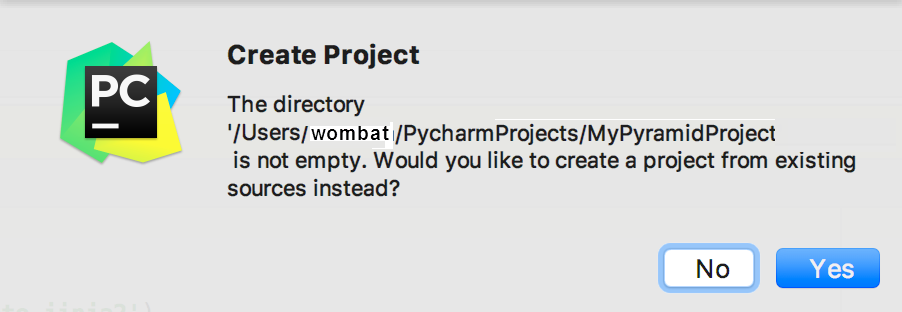Creating Pyramid Project
Pyramid project scaffolds are intended for productive development of Pyramid applications. PyCharm takes care of creating the specific directory structure and settings.
To create a Pyramid project, follow these steps
On the main menu, choose , or click the New Project button in the Welcome screen. New Project dialog box opens. In the New Project dialog box, do the following:
Specify project type Pyramid.
Specify project location.
- Next, click
 to expand the Project Interpreter node, and select the new environment or existing interpreter, by clicking the corresponding radio-button. The following steps depend on your choice:
to expand the Project Interpreter node, and select the new environment or existing interpreter, by clicking the corresponding radio-button. The following steps depend on your choice: - New environment using: if this option has been selected, choose the tool to be used to create a virtual environment. To do that, click the drop-down list and choose Virtualenv, Pipenv, or Conda.
Next, specify the location and base interpreter of the new virtual environment. If necessary, click the Inherit global site-packages and Make available to all projects check boxes.
Existing interpreter: if this option has been selected, choose the desired interpreter from the drop-down list, or (if the desired interpreter is not found), click
 and choose the interpreter. See Configuring Python Interpreter for details.
and choose the interpreter. See Configuring Python Interpreter for details.
- New environment using: if this option has been selected, choose the tool to be used to create a virtual environment. To do that, click the drop-down list and choose Virtualenv, Pipenv, or Conda.
 (More Settings), and specify the following:
(More Settings), and specify the following: - From the drop-down list, select the scaffold to be used. The possible options are:
startedalchemyzodb
From the drop-down list, select the template language to be used.
In the Templates folder field, specify the directory where the templates will be stored, and where they will be loaded from. You can specify the name of the directory that doesn't yet exist; in this case, the directory will be created.
- Click Create.
If an alert pops up,

click
No. We are creating a new project.PyCharm creates a project, installs Pyramid and its dependencies, and produces specific directory structure, which you can explore in the Project tool window. Open any file in the project directory. If there are unsatisfied package requirements, PyCharm suggests to resolve or ignore them:

You should install the dependencies to be able to run the development server.
When you create a Pyramid project, you must run
setup.py developto install the project for development. PyCharm might inform you to do so as shown in the screenshot below:
Alternatively, you can select and enter
develop. Another pop-up dialog appears Run Setup Task develop. Click OK.If you created an alchemy-based project, you need to initialise the database, open the terminal (make sure virtual environment is active) and run the command:
initialize_PROJECTNAME_db development.ini(Replace
PROJECTNAMEwith your exact project name.)